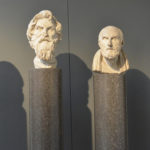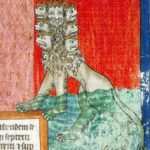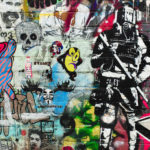We run our website the way we wished the whole internet worked: we provide high quality original content with no ads. We are funded solely by your direct support. Please consider supporting this project.
How Revelation Uses Violent Images in an Anti-Violent Way
All the violent scenes in Revelation are symbols for the battle of truth and deception. They never involve literal violence. In fact, they symbolize ANTI-VIOLENCE. The ingenious way John helps us get free of deception of trust in violent power is by taking a standard violent symbol and juxtaposing it with a symbol that undermines its violence and reverses its violent meaning.
An interesting example of this is when John introduces the mysterious 144,000, which represent the army that fights with the Lamb. They are introduced in Revelation 7: 4: “Then I heard the number of those who were sealed: 144,000 from all the tribes of Israel.”
The 144,000 was a well known Jewish symbol of the army that would accompany the Messiah in a violent uprising against Israel’s foes to restore Israel to its place as a sovereign nation.
But this image of violence gets turned on its head. One example of this is found in Revelation 7:14: “These are they who have come out of the great tribulation; they have washed their robes and made them white in the blood of the Lamb.”
If you read Revelation literally, you have to wonder how washing a robe in blood could make it white. Taken literally its absurd, but interpreted symbolically its profound because this washing of the robes is a Jewish military metaphor.
To be covered with another’s blood rendered you ceremonially unclean, so when Jewish warriors came back from battle covered with the blood of their enemies, they had to go through a purification bathing process before they could reenter society. Instead of washing OFF the blood of foes to become clean, these warriors are made clean by being washed IN blood – and it’s the blood of the one they followed into battle!
Many scholars believe John is not simply saying their sins are washed away by the blood of the lamb, though that is of course true. He is also saying that this army wears white linen because they shared in the blood of the Lamb.
They were willing to suffer with Christ. As it says in chapter 14, this 144,000 was willing to “follow the lamb wherever he goes,” even to the cross. While the standard image of the army of 144,000 following their messiah into battle was based on Babylon’s sword power, John has turned it on its head to communicate slain lamb power — the power of self-sacrificial love.
We are indeed part of an army, but not one that wins by shedding blood: we win by shedding our blood, just as Jesus did.
Category: General
Tags: Book of Revelation, Cruciform Theology, Non-Violence, Violence
Related Reading

Challenging the Assumptions of Classical Theism
What came to be known as the classical view of God’s nature has shaped the common, traditional way that most people think about God. It is based in the logic borrowed, mostly unconsciously, from a major strand within Hellenistic philosophy. In sharp contrast to ancient Israelites, whose conception of God was entirely based on their…

Is the New Testament Ambiguous About Non-Violence?
One could argue, with some legitimacy, that the portrait of God in the NT is not unambiguously non-violent, the revelation of God on Calvary notwithstanding. It can’t be denied that there are violent-appearing images of God in certain teachings of Jesus and certain NT authors, especially when it comes to their eschatological teachings. In addition,…

Should churches have armed security guards?
Question: Recently (December, 2007) a security guard at New Life Church in Colorado Springs shot and apparently killed a man who was shooting people in the church parking lot. The pastor (Brady Boyd) hailed her as a “real hero.” Do you think churches should have armed security guards and do you think the pastor was…

Would God Kill a Baby To Teach Parents a Lesson?
Question: We have a group of guys that are going through your book “Is God to Blame” and a question came up that I would be curious how you would look at it. In the beginning of the book you ask the question “do you really think that God kills babies to teach parents a lesson?”…

The All-Too-Common Montage God
How do you picture God? It’s impossible to exaggerate the importance of a believer’s mental picture of God. The intensity of your love for God will never outrun the beauty of the God you envision in your mind. So our mental picture of God completely determines the quality of our relationship with God. In fact,…

The Greatest in the Kingdom (2 of 2)
Article by Natalie Frisk This post is a summary of what was discussed at the ReKnew CrossVision Conference in regard to what and how we teach our kids about the cruciform hermeneutic. Taking Jesus into the Old Testament I co-lead a family-friendly home church where we sometimes get into spiritually deep conversations with children. There…
